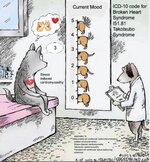Lori
Well-known member
Broken Heart Syndrome
While anyone can face a broken heart, broken heart syndrome (also known as takotsubo cardiomyopathy or stress cardiomyopathy) is a condition almost unique to women between the age of 50-80. The cause of the heart condition is not completely known, but is thought to be triggered by adrenaline which surges in stressful situations.
While the condition is uncommon, women who do experience Broken Heart syndrome present symptoms just like an acute heart attack — experiencing acute chest pain, shortness of breath, and EKGs which look very much like an acute Myocardial Infarction (MI). The difference between this and a true heart attack is that the heart arteries in broken heart syndrome typically have no significant blockage. The other major difference is that in broken heart syndrome the damage that occurs to the heart heals fairly rapidly (sometimes in as little as a few weeks).

 www.bswhealth.com
www.bswhealth.com
Broken Heart Syndrome, also known as Takotsubo Syndrome (TS), is sudden and transient dysfunction of the left and/or right ventricle which often mimics Acute Coronary Syndrome (ACS). Japan was the first country to describe this syndrome in the 1990s, and since then it has received a lot of attention from researchers all around the world. Although TS was once thought to be a harmless condition, recent evidence suggests that it may be linked to serious complications and mortality on par with Acute Coronary Syndrome (ACS). The understanding of TS has evolved over the past few years. However, its exact etiology is still poorly understood. It can be classified into two main types: Primary and Secondary TS. Primary TS occurs when the symptoms of myocardial damage, which is typically preceded by emotional stress, are the reason for hospitalization. Secondary TS is seen in patients hospitalized for some other medical, surgical, obstetric, anesthetic, or psychiatric conditions, and the dysfunction develops as a secondary complication due to the activation of the sympathetic nervous system and the release of catecholamines. The etiopathogenesis is now proposed to include adrenergic hormones/stress, decreased estrogen levels, altered microcirculation, endothelial dysfunction, altered inflammatory response via cardiac macrophages, and disturbances in the brain-heart axis

 www.ncbi.nlm.nih.gov
www.ncbi.nlm.nih.gov
2023 ICD-10-CM Diagnosis Code I51.81
Takotsubo syndrome
Applicable To
Broken heart syndrome is often diagnosed in an emergency or hospital setting because symptoms mimic a heart attack.
To diagnose broken heart syndrome, the health care provider examines you and asks questions about your symptoms and medical history. You may be asked if you've had any major stresses recently, such as the death of a loved one.
People who have broken heart syndrome usually don't have any heart disease symptoms before the condition is diagnosed.
Treatment
There's no standard treatment for broken heart syndrome. Treatment is similar to heart attack care until the diagnosis is clear. Most people stay in the hospital while they get better.
Many people with broken heart syndrome fully recover within a month or so. An echocardiogram is done about 4 to 6 weeks after the first symptoms to make sure the heart is recovered.
 www.mayoclinic.org
www.mayoclinic.org

While anyone can face a broken heart, broken heart syndrome (also known as takotsubo cardiomyopathy or stress cardiomyopathy) is a condition almost unique to women between the age of 50-80. The cause of the heart condition is not completely known, but is thought to be triggered by adrenaline which surges in stressful situations.
While the condition is uncommon, women who do experience Broken Heart syndrome present symptoms just like an acute heart attack — experiencing acute chest pain, shortness of breath, and EKGs which look very much like an acute Myocardial Infarction (MI). The difference between this and a true heart attack is that the heart arteries in broken heart syndrome typically have no significant blockage. The other major difference is that in broken heart syndrome the damage that occurs to the heart heals fairly rapidly (sometimes in as little as a few weeks).
Broken Heart Syndrome: Can you die from a broken heart?
While anyone can face a broken heart, broken heart syndrome (also known as takotsubo cardiomyopathy or stress cardiomyopathy) is a condition almost un...
Broken Heart Syndrome, also known as Takotsubo Syndrome (TS), is sudden and transient dysfunction of the left and/or right ventricle which often mimics Acute Coronary Syndrome (ACS). Japan was the first country to describe this syndrome in the 1990s, and since then it has received a lot of attention from researchers all around the world. Although TS was once thought to be a harmless condition, recent evidence suggests that it may be linked to serious complications and mortality on par with Acute Coronary Syndrome (ACS). The understanding of TS has evolved over the past few years. However, its exact etiology is still poorly understood. It can be classified into two main types: Primary and Secondary TS. Primary TS occurs when the symptoms of myocardial damage, which is typically preceded by emotional stress, are the reason for hospitalization. Secondary TS is seen in patients hospitalized for some other medical, surgical, obstetric, anesthetic, or psychiatric conditions, and the dysfunction develops as a secondary complication due to the activation of the sympathetic nervous system and the release of catecholamines. The etiopathogenesis is now proposed to include adrenergic hormones/stress, decreased estrogen levels, altered microcirculation, endothelial dysfunction, altered inflammatory response via cardiac macrophages, and disturbances in the brain-heart axis

Broken Heart Syndrome: Evolving Molecular Mechanisms and Principles of Management
Broken Heart Syndrome, also known as Takotsubo Syndrome (TS), is sudden and transient dysfunction of the left and/or right ventricle which often mimics Acute Coronary Syndrome (ACS). Japan was the first country to describe this syndrome in the 1990s, ...
2023 ICD-10-CM Diagnosis Code I51.81
Takotsubo syndrome
Applicable To
- Reversible left ventricular dysfunction following sudden emotional stress
- Stress induced cardiomyopathy
- Takotsubo cardiomyopathy
- Transient left ventricular apical ballooning syndrome
Broken heart syndrome is often diagnosed in an emergency or hospital setting because symptoms mimic a heart attack.
To diagnose broken heart syndrome, the health care provider examines you and asks questions about your symptoms and medical history. You may be asked if you've had any major stresses recently, such as the death of a loved one.
People who have broken heart syndrome usually don't have any heart disease symptoms before the condition is diagnosed.
Treatment
There's no standard treatment for broken heart syndrome. Treatment is similar to heart attack care until the diagnosis is clear. Most people stay in the hospital while they get better.
Many people with broken heart syndrome fully recover within a month or so. An echocardiogram is done about 4 to 6 weeks after the first symptoms to make sure the heart is recovered.
Broken heart syndrome - Diagnosis and treatment - Mayo Clinic



